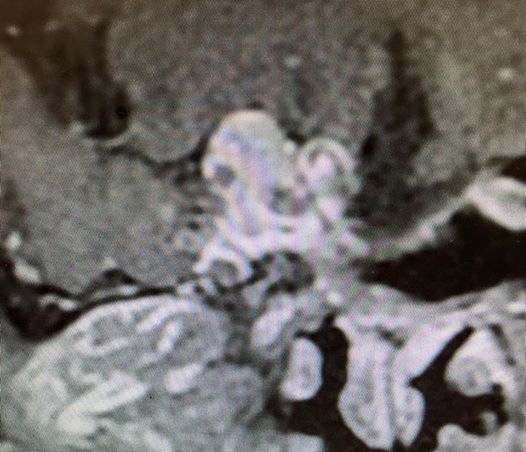From Lewis S. Blevins Jr. MD – This person has residual growth hormone producing pituitary adenoma that was inaccessible to the surgeon via the transsphenoidal route. I must say, however, that about 90 to 95% of all tumor was successfully removed. The residuals tumor is located superior to and within the cavernous sinus on the right. It indents the under surface of the brain. The only way to remove a tumor like this is to go through the skull. Then, it would not be removed in its entirety because it is within the cavernous sinus amongst blood vessels and nerves. At the midpoint on the left side of the tumor depicted one can see a small circular gray area relative to the white contrast enhancing part of the tumor. That small area is the cross-section of the oculomotor or third cranial nerve.
The oculomotor nerve emanates from the brainstem, runs through the cavernous sinus, and then enters the orbit containing the eyeball. It controls, along with the fourth and six cranial nerves, eyeball movement. The third nerve is also responsible for control of the upper eyelid. Sometimes, pituitary tumor invading the cavernous sinus compresses this nerve and causes problems. Also, patients who experience pituitary apoplexy may have sudden onset of compression of this nerve. Oculomotor nerve problems lead to double vision due to partial paralysis of the eyeball and a droopy eyelid on the affected side. Removing the pressure on the nerve by resecting as much tumor as is possible sometimes restores eye movement function to normal.
Two other conditions that cause oculomotor problems that can mimic the same problems seen in patients with pituitary tumors include infarction of the nerve in patients with long-standing uncontrolled diabetes mellitus and an aneurysm of the posterior communicating artery of the circle of Willis.
© 2014 – 2024, J D Faccinetti. All rights reserved.

What does the last sentence mean?? The artery of the circle of Willis??? Iam having trouble with one of my eyelids dropping down and causing me a lot of problems. I am going to ask Dr about this article today!!!!! He is labeling it an eye migrane so far and letting it go as that?!?! But this article keeps coming to my mind!!!! I have to ask about this!!!! Thanks!